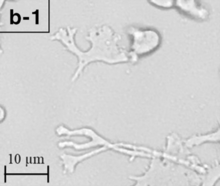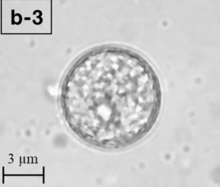Balamuthia mandrillaris is a free-living amoeba that is known to cause the rare but deadly neurological condition known as granulomatous amoebic encephalitis (GAE).[1] B. mandrillaris is a soil dwelling amoeba and was first discovered in 1986 in the brain of a mandrill that died in the San Diego Wild Animal Park.
B. mandrillaris can infect the body through open wounds or by inhalation.[2] Balamuthiahas been isolated in nature.[3][4] It is believed to be distributed throughout the temperate regions of the world. This is supported somewhat by the detection of antibodies to the protist in healthy individuals.
The generic name Balamuthia was given by Govinda Visvesvara (b. September 28, 1931), in honor of his late mentor, parasitologist William Balamuth (1914–1981), for his contributions to the study of amoebae. It was in 1993 when Visvesvara isolated and studied the pathogen for the first time.[5]
| Balamuthia mandrillaris | |
|---|---|
 | |
| Trophozoite (active) form of Balamuthia mandrillaris | |
 | |
| A Balamuthia mandrillaris cyst | |
| Scientific classification | |
| Domain: | |
| Phylum: | |
| Class: | |
| Order: | |
| Family: | Balamuthiidae |
| Genus: | Balamuthia Visvesvara et al., 1993 |
| Species: | B. mandrillaris |
| Binomial name | |
| Balamuthia mandrillaris Visvesvara et al., 1993 | |
https://en.wikipedia.org/wiki/Balamuthia_mandrillaris
No comments:
Post a Comment